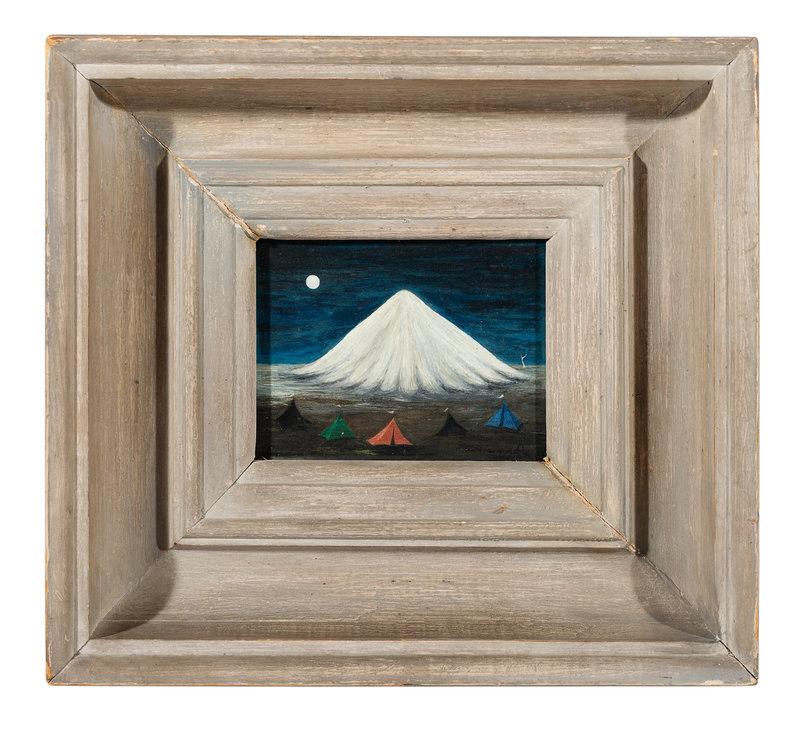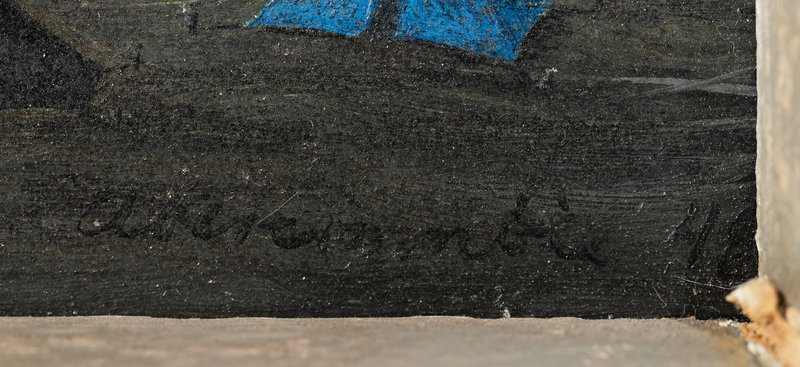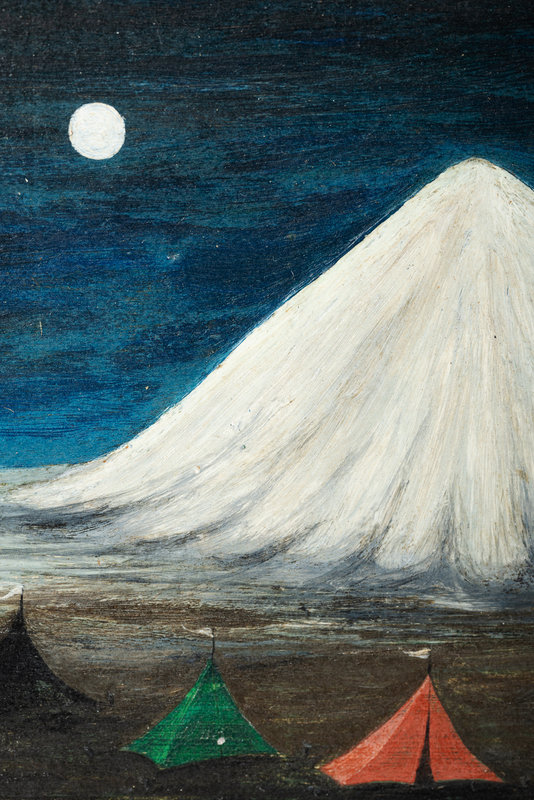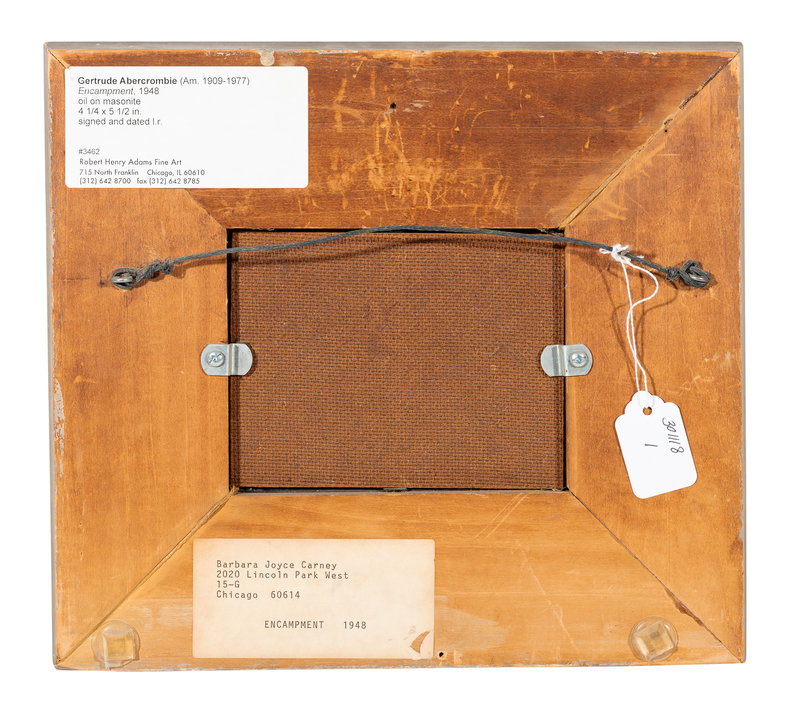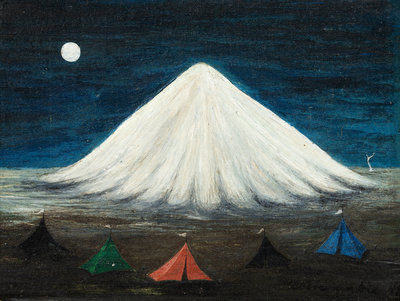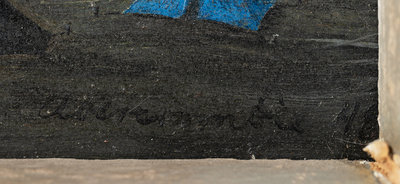Gertrude Abercrombie
(American, 1909-1977)
Encampment (White Mountain)
, 1948
Sale 1027 - Post War & Contemporary Art
May 11, 2022
10:00AM CT
Live / Chicago
Own a similar item?
Estimate
$40,000 -
60,000
Price Realized
$125,000
Sold prices are inclusive of Buyer’s Premium
Lot Description
Gertrude Abercrombie
(American, 1909-1977)
Encampment (White Mountain)
, 1948oil on masonite
signed Abercrombie and dated (lower right)
4 1/4 x 5 1/2 inches.
We are grateful for the research conducted by Susan Weininger, Professor Emerita, Roosevelt University.
Provenance:
The Artist
Dr. Sachnoff, Chicago, acquired directly from the Artist
Barbara Joyce Carney, Chicago, daughter of the above
Robert Henry Adams Fine Art, Chicago
Sold: Leslie Hindman Auctioneers, Chicago, May 4, 2009, Lot 1
Acquired directly from the above sale by the present owners
Exhibited:
Chicago Public Library, Art Room (now the Chicago Cultural Center), 1948
Chicago, State of Illinois Art Gallery, Gertrude Abercrombie, March 18 - May 17, 1991 (also traveled to Springfield, Illinois, Illinois State Museum, July 28 - October 25, 1991), pp. 28-29; 91, illus.
Literature:
Robert Storr, Susan Weininger, Robert Cozzolino, Robert, Dinah Livingston, Studs Terkel, Gertrude Abercrombie, New York, 2018, pp. 283; 483, illus.
Lot Note:
Much like the jazz she adored, Gertrude Abercrombie riffed in her art with repeated symbols and images, combined to create otherworldly scenes rooted in the real. Her enigmatic paintings full of recurring cyphers caused her to be grouped with the Surrealists or magic realists. Abercrombie embraced the label, stating, “I am not interested in complicated nor in the commonplace, I like to paint simple things that are a little strange. My work comes directly from my inner consciousness and it must come easily. It is a process of selection and reduction (quoted in Donna Seaman, “Girl Searching,” Identity Unknown, p. 31). Her paintings are also deeply autobiographical and illuminate a complex psyche.
Provenance:
The Artist
Dr. Sachnoff, Chicago, acquired directly from the Artist
Barbara Joyce Carney, Chicago, daughter of the above
Robert Henry Adams Fine Art, Chicago
Sold: Leslie Hindman Auctioneers, Chicago, May 4, 2009, Lot 1
Acquired directly from the above sale by the present owners
Exhibited:
Chicago Public Library, Art Room (now the Chicago Cultural Center), 1948
Chicago, State of Illinois Art Gallery, Gertrude Abercrombie, March 18 - May 17, 1991 (also traveled to Springfield, Illinois, Illinois State Museum, July 28 - October 25, 1991), pp. 28-29; 91, illus.
Literature:
Robert Storr, Susan Weininger, Robert Cozzolino, Robert, Dinah Livingston, Studs Terkel, Gertrude Abercrombie, New York, 2018, pp. 283; 483, illus.
Lot Note:
Much like the jazz she adored, Gertrude Abercrombie riffed in her art with repeated symbols and images, combined to create otherworldly scenes rooted in the real. Her enigmatic paintings full of recurring cyphers caused her to be grouped with the Surrealists or magic realists. Abercrombie embraced the label, stating, “I am not interested in complicated nor in the commonplace, I like to paint simple things that are a little strange. My work comes directly from my inner consciousness and it must come easily. It is a process of selection and reduction (quoted in Donna Seaman, “Girl Searching,” Identity Unknown, p. 31). Her paintings are also deeply autobiographical and illuminate a complex psyche.
In addition to cats, moons, trees, and gloves (among other symbols), tents were added to Abercrombie’s personal lexicon during the late 1940s and early 1950s. The germinal tent painting, Between Two Camps, 1948 (Illinois State Museum, Springfield), is related to Abercrombie’s divorce and remarriage the same year. As an inherently precarious and temporary dwelling, a tent is used as a metaphor for her failing first marriage. The artist painted rooms for most of her career, almost always sealed and inaccessible, so solid that they take on the feelings of emptiness and inability to connect that the artist often felt. As an enclosure, the tent parallels the ubiquitous rooms that serve as psychic self-portraits but are more fraught with uncertainty.
The tents in the Encampment (White Mountain), 1948, represent a temporary and ephemeral refuge, undependable, and subject to the whims of nature. Their transitoriness is emphasized when contrasted to the solid white mountain behind them. Even though Abercrombie desired the divorce, there may have been some trepidation. Her second husband, Frank Sandiford, had been a small-time criminal and often did not have steady employment. In contrast, Bob Livingston, her first husband, was an attorney, a stable provider, and a good father to their daughter Dinah. The work echoes the artist’s own doubts and insecurity, even as she takes a step toward an altered life.
Condition Report
Auction Specialist

